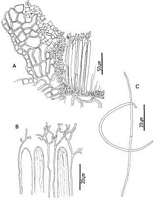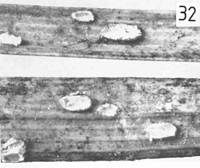|
 Marthamyces dracophylli Marthamyces dracophylli
SynonymsPropolis dracophylli
BiostatusPresent in region - Indigenous. Endemic
Images (click to enlarge)
Caption: Fig. 18.Propolis dracophylli: A, ascocarp margin in cross-section. B, apices of asci and
paraphyses. C, released ascospores. | 
Caption: Fig. 32 Macroscopic appearance of ascocarp (x 12).
P. dracophylli. |
Article: Johnston, P.R. (1986). Rhytismataceae in New Zealand. 1. Some foliicolous species of Coccomyces de Notaris and Propolis (Fries) Corda. New Zealand Journal of Botany 24(1): 89-124 (http://www.rsnz.org/publish/abstracts.php).
Description: Ascocarps developing on upper and lower surfaces of fallen leaves. Not associated with a
differentiated lesion or zone lines. Ascocarps round or elliptic in outline, 0.3-0.7 mm diam.
Immature ascocarps have the appearance of small, raised pustules on leaf surface. Opening by
several, irregular splits, with the covering host and fungal tissue folding back to expose the
white, pruinose hymenium.
Ascocarps deeply immersed in hypodermal tissue. In vertical section more or less orbicular in
shape. Upper wall poorly developed, comprising 3-4 layers of hyaline, gelatinised hyphae,
2.5-4 µm diam. Inside of wall lined with a layer of unbranching periphyses, 8-10 x 2-3
µm. Crystals form amongst the periphyses and wall hyphae near the top of the margin.
Lower wall not present, subhymenium 10-20 µm wide, forming directly on disintegrating
host tissue.
Paraphyses 0.8-1.2 µm diam., propoloid, tangled together, intermixed with crystals near the
apices, often anastomosing near bases, extending 15-20 µm beyond asci. Asci 114-147 x
7.5-9 µm, cylindric, tapering to the small truncate, or broadly rounded, apex, non-amyloid,
8-spored. Ascus wall thickened near apex, with a broad, central pore. Ascospores filiform,
not tapering, often coiling on release, 80-112 x 1.2-1.5 µm, 0-1 septate, with a gelatinous
cap at both ends.
CHARACTERISTICS IN CULTURE: Ascospores germinated on agar plates after 2-3 days.
Colonies on oatmeal agar 2-3 cm diam. after 8 weeks; aerial mycelium white, cottony, erect;
agar pink, with yellow patches near edges of colony. Remaining sterile.
Habitat: Found on fallen leaves of Dracophyllum species.
Notes: ETYMOLOGY: dracophylli; refers to host plant.
NOTES: The structure of the ascocarp margin and the appearance of the ascus apex of this
species are similar to those of some Ostropalean genera such as Stictis and Propolidium.
However 0-1 septate ascospores with a gelatinous sheath, and anastomosing paraphyses are
distinctive Rhytismataceous characters. The external appearance of the ascocarp conforms to
that of Propolis.
|